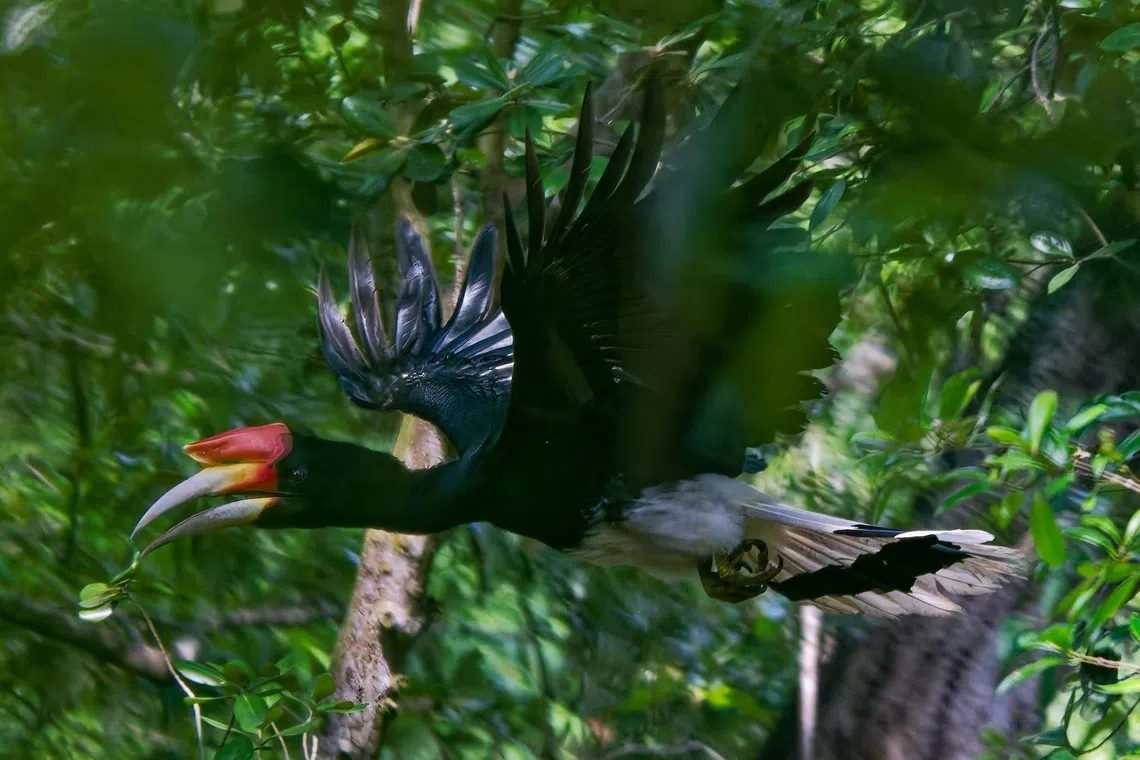Rare hornbill species once thought extinct in Singapore spotted in Sungei Buloh Wetlands
Sign up now: Get ST's newsletters delivered to your inbox

The rhinoceros hornbill, known to be locally extinct, was spotted at Sungei Buloh Wetland Reserve, on Oct 28 and 29.
PHOTO: BAI QW/FACEBOOK
Follow topic:
SINGAPORE – A rare rhinoceros hornbill – believed to be extinct in Singapore since the last wild bird was spotted about 200 years ago – got nature lovers all aflutter by appearing in Sungei Buloh Wetland Reserve.
For two days since Oct 28, when the hornbill was first spotted, bird-watching enthusiasts and wildlife photographers have flocked to the reserve with cameras and phones in tow, and flooded social media platforms with photos and video footage of the bird.
The rhinoceros hornbill is a large bird with black plumage, a white belly and a distinctive red-orange casque on its bill.
Mr David Tan, 60, who is retired after a career in the Singapore Armed Forces, said the sighting was unexpected and a rare treat for wildlife photographers who caught a glimpse of the bird and got a photo too.
He said he arrived at the reserve at about 8.15am on Oct 28, after fellow wildlife enthusiasts in one of his WhatsApp groups shared reports that the bird was spotted earlier that morning.
“I managed to get a decent shot only about an hour later as the bird was largely hidden in the tree canopy,” said Mr Tan, who later posted his photos on Facebook and Instagram.
Although it was his first sighting of the bird, he managed to identify it through visual observation and used bird identification apps to confirm the species.
“It is possible the hornbill might have flown in from Malaysia,” he said.
The rhinoceros hornbill is Malaysia’s national bird and the state bird of Sarawak.
Bird Society of Singapore vice-president Raghav Narayanswamy said there are records of rhinoceros hornbill sightings in Singapore, but they are believed to be birds that escaped from captivity.
“Sightings of locally extinct bird species are significant as they suggest our forests remain connected to the wider region,” he said.
“However, we still need to assess whether this is a truly wild bird or one that escaped from a private collection, either in Singapore or across the border in Johor.”
He said members of the public can submit records of rare bird through the society’s online portal, where experts will vote on whether a sighting is of wild or captive origin.
Conservation biologist Yong Ding Li, a regional coordinator at BirdLife International, said the rhinoceros hornbill is a species that depends on large forest landscapes across South-east Asia.
“Escaped hornbills are seen in Singapore from time to time, but this particular bird could have flown in naturally,” he said.
He added that wild populations still exist in Malaysian forests like Mount Pulai, about 20km north of Sungei Buloh.
Dr Yong said: “The bird sighted here is a juvenile, which makes it less likely to have come from captivity. Rhinoceros hornbills are excellent dispersers and can travel long distances in search of fruit.
“The bird does not need to be rescued as it is perfectly healthy.”
Associate Professor Frank Rheindt from the Lee Kong Chian Natural History Museum at the National University of Singapore agreed that the bird was “likely a wandering individual from Peninsular Malaysia”.
He said: “The rhinoceros hornbill requires vast home ranges and old-growth trees with large cavities for nesting. It has disappeared from much of the Thai-Malay Peninsula, including Singapore, due to forest loss.”
According to the non-profit environment group Cicada Tree Eco Place, the last record of a wild rhinoceros hornbill seen in Singapore was in the late 1800s.
The Straits Times in 2009 reported that a wild rhinoceros hornbill, an escapee, was living in Bukit Timah Nature Reserve and that Singapore researchers were exploring possible suitors for the female to breed with.
Native to South-east Asian countries including Malaysia, Indonesia and Thailand, the bird is monogamous, nesting in tree trunks and feeding mainly on fruit.


